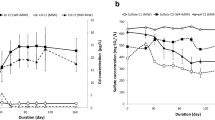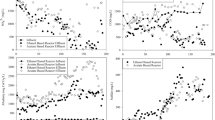Abstract
Environmentally recalcitrant pollutants (chromium and sulphate) from mixed effluents of tannery and paper mills were treated simultaneously using highly metal-resistant dissimilatory sulphate-reducing bacteria. The remedial efficiency of the bacteria appeared zero when the bacterial pure culture was employed without the addition of any growth substrate from external source, while the bacterial sulphate reduction and consequent metal removal appeared maximum when sodium lactate was added as growth substrate in another set of experiments. In this set of experiments, almost 100% precipitation of the chromium (700 ppm) occurred in the first 7 days of anaerobic incubation. Sulphate was also removed totally (1225 ppm) in the first 7 days of incubation. pH of the media remained in the neutral to slightly basic range throughout the experimental trial. The achievement of maximum remedial efficiency also depicts the ultimate preference of lactate as carbon source by sulphate-reducing bacteria. The outcomes of the present investigation can be fruitful for designing efficient, environment-friendly and economical bioremedial strategies.



Similar content being viewed by others
References
Abhishek A, Dwivedi A, Tandan N, Kumar U (2017) Comparative bacterial degradation and detoxification of model and Kraft lignin from pulp paper wastewater and its metabolites. Appl Water Sci 7:757–767
Aguado J, Arsuaga JM, Arencibia A, Lindo M, Gascon V (2009) Aqueous heavy metals removal by adsorption on aminefunctionalized mesoporous silica. J Hazard Mater 163:213–221
APHA-AWWA-WPCF (2005) Standard methods for the examination of water and wastewater. American Public Health Association, Washington, D. C 20th ed, New York
Aslam S, Hussain A, Qazi JI (2016) Dual action of chromium-reducing and nitrogen-fixing Bacillus megaterium-ASNF3 for improved agro-rehabilitation of chromium-stressed soils. 3 biotech 6: 125 https://doi.org/10.1007/s13205-016-0443-5
Aslam S, Hussain A, Qazi JI (2019) Production of cellulase by Bacillus amyloliquefaciens-ASK11 under high chromium stress. Waste Biomass Valor 10:53–61. https://doi.org/10.1007/s12649-017-0046-3
Aslam S, Qazi JI, Hussain A, Ali S (2014) Vertical zonation and seed germination indices of chromium resistant cellulolytic and nitrogen fixing bacteria from a chronically metal exposed land area. Pak J Bot 46:2257–2268
Azmat H, Ali W, Javid A, Hussain A, Hussain SM, Saeed Z, Bukhari SSH (2016) Chromium contamination in water, sediment and its bioaccumulation in Indian major carps in river Chenab, Pakistan. Punjab Univ J Zool 31:83–86
Barton LL (1995) Sulfate-reducing Bacteria. Plenum Press, New York
Batool S, Hussain A, Iqbal MA, Javid A, Ali W, Bukhari SM, Akmal M, Qazi JI (2019) Implication of highly metal-resistant microalgal-bacterial co-cultures for the treatment of simulated metal-loaded wastewaters. Int Microbiol 22:41–48. https://doi.org/10.1007/s10123-018-0025-y
Beaulieu S, Zagury GJ, Descheˆnes L, Samson R (2000) Bioactivation and bioaugmentation of a passive reactor for acid mine drainage treatment. In: Singhal RK, Mehrotra AK (eds) Environmental issues and Management of Waste in energy and mineral production. Rotterdam, Netherlands, pp 533–537
Bhatti MT, Latif M (2011) Assessment of water quality of a river using an indexing approach during the low flow season. Irrig Drain 60:103–114
Bi C, Zhou Y, Chen Z, Jia J, Bao X (2018) Heavy metals and lead isotopes in soils, road dust and leafy vegetables and health risks via vegetable consumption in the industrial areas of Shanghai, China. Sci Total Environ 619–620:1349–1357
Bratkova S, Koumanova B, Beschkov V (2013) Biological treatment of mining wastewaters by fixed-bed bioreactors at high organic loading. Bioresour Technol 137:409–413
Cabrera G, Pe’rez R, Gómez JM, Ábalos A, Cantero D (2006) Toxic effects of dissolved heavy metals on Desulfovibrio vulgaris and Desulfovibrio sp. strains. J Hazard Mater 135:40–46
Chandra R, Pandey PK, Srivastava A (2004) Comparative toxicological evolution of untreated and treated tannery effluent with Nostoc muscorum L. (algal assay) and microtox bioassay. Environ Monit Assess 95:287–294
Chandrasekaran K, Selvaraj H, Sundaram M (2019) Electrochemical oxidation with the aerobic pretreatment process for sulfate-rich tannery effluent. Environ Sci Pollut Res 26:12194. https://doi.org/10.1007/s11356-019-04614-3
Costa JM, Rodriguez RP, Sancinetti GP (2017) Removal of sulfate and metals Fe+2, cu+2, and Zn+2 from acid mine drainage in an anaerobic sequential batch reactor. J Environ Chem Eng 5(2):1985–1989. https://doi.org/10.1016/j.jece.2017.04.011
Costa MC, Duarte JC (2005) Bioremediation of acid mine drainage using acidic soil and organic wastes for promoting sulphate reducing bacteria activity on a column reactor. Water Air Soil Pollut 165:325–345
Cydzik-Kwiatkowska A, Zielińska M (2016) Bacterial communities in full-scale wastewater treatment systems. World J Microbiol Biotechnol 32:1–8
Durai G, Rajasimman M (2011) Biological treatment of tannery wastewater- a review. J Environ Sci Technol 4(1):1–17
El-Samrani AG, Lartiges BS, Villie’ras F (2008) Chemical coagulation of combined sewer overflow: heavy metal removal and treatment optimization. Water Res 42:951–960
Garg SK, Bhatnagar A, Kalla A, Johal MS (2000) Experimental ichthyology. CBS, New Delhi
Gillespie IMM, Philp JC (2013) Bioremediation, an environmental remediation technology for the bioeconomy. Trends Biotechnol 31:329–332
Goyer RA, Clarkson TW (2001) Toxic effects of metals. In: Klaassen CD (ed) Casarett and Doull’s toxicology: the basic science of poisons. McGraw-Hill, New York, pp 811–867
Hussain A, Ashraf M, Altaf M, Khan WA, Akmal M, Qazi JI (2015b) Relative diversity and threats to commercially important fishes of the Ravi, Pakistan. Biologia (Pakistan) 61:145–149
Hussain A, Aslam S, Javid A, Rashid M, Hussain I, Qazi JI (2019b) Biphasic treatment system for the removal of toxic and hazardous pollutants from industrial wastewaters. In: Bharagava RN, Chowdhary P (eds) Emerging and eco-friendly approaches for waste management. Springer, Berlin, pp 397–421
Hussain A, Hasan A, Javid A, Qazi JI (2016) Exploited application of sulfate-reducing bacteria for concomitant treatment of metallic and non-metallic wastes: a mini review. 3 Biotech 6: 119 https://doi.org/10.1007/s13205-016-0437-3
Hussain A, Iqbal MA, Javid A, Razaq A, Aslam S, Hasan A, Akmal M, Qazi JI (2019a) Application of fruit wastes as cost-effective carbon sources for biological sulphate reduction. Iran J Sci Technol Trans Sci 43:33–41. https://doi.org/10.1007/s40995-017-0436-1
Hussain A, Qazi JI (2012) Biological sulphate reduction using watermelon rind as a carbon source. Biologia (Pakistan) 58:85–92
Hussain A, Qazi JI (2016a) Application of sugarcane bagasse for passive anaerobic biotreatment of sulphate rich wastewaters. Appl Water Sci 6:205–211. https://doi.org/10.1007/s13201-014-0226-2
Hussain A, Qazi JI (2016b) Metals-induced functional stress in sulphate-reducing thermophiles. 3 biotech 6: 17 https://doi.org/10.1007/s13205-015-0342-1
Hussain A, Qazi JI, Shakir HA (2014a) Implication of molasses as electron donor for biological sulphate reduction. Am J Environ Eng 4:7–10
Hussain A, Shakir HA, Ali S, Qazi JI (2015a) Growth coefficient and fecundity of Chitala chitala (Osteoglossiformes: Notopteridae) from the river Ravi, Pakistan. J Anim Plant Sci 25:401–405
Hussain A, Shakir HA, Qazi JI (2014b) Anaerobic biodegradation of sulphate employing animal manure as a cost-effective growth substrate. J Anim Plant Sci 24:913–918
Ihsanullah Abbas A, Al-Amer AM, Laoui T, Al-Marri MJ, Nasser MS, Khraisheh M, Atieh MA (2016) Heavy metal removal from aqueous solution by advanced carbon nanotubes: critical review of adsorption applications. Sep Purif Technol 157:141–161
Jaishankar M, Tseten T, Anbalagan N, Mathew BB, Beeregowda KN (2014) Toxicity, mechanism and health effects of some heavy metals. Interdiscip Toxicol 7(2):60–72
Kim IS, Ekpeghere KI, Ha SY, Kim BS, Song B, Kim JT, Kim HG, Koh SC (2014) Full-scale biological treatment of tannery wastewater using the novel microbial consortium BM-S-1. J Environ Sci Health A 49(3):355–364
Kuppusamy S, Jayaraman N, Jagannathan M, Kadarkarai M, Aruliah R (2017) Electrochemical decolorization and biodegradation of tannery effluent for reduction of chemical oxygen demand and hexavalent chromium. J Water Process Eng 20:22–28
Li HX, Ji HB, Shi CJ, Yang G, Yan Z, Xu XY, Ding HJ, Tang L, Xing YX (2017) Distribution of heavy metals and metalloids in bulk and particle size fractions of soils from coal-mine brownfield and implications on human health. Chemosphere 172:505–515
Liamleam W, Annachhatre AP (2007) Electron donors for biological sulfate reduction. Biotechnol Adv 25:452–463
Martins M, Faleirob ML, Barros RJ, Verı’ssimo AR, Barreirosd MA, Costa MC (2009) Characterization and activity studies of highly heavy metal resistant sulphate-reducing bacteria to be used in acid mine drainage decontamination. J Hazard Mater 166:706–713
Mehr MR, Keshavarzi B, Moore F, Sharifi R, Lahijanzadeh A, Kermani M (2017) Distribution, source identification and health risk assessment of soil heavy metals in urban areas of Isfahan province, Iran. J Afr Earth Sci 132:16–26
Mortazavi F, Jafari-Javid A (2009) Acute renal failure due to copper sulfate poisoning; a case report. Iran J Pediatr 19:75–78
Muhammad SN, Kusin FM, Madzin Z (2017) Coupled physicochemical and bacterial reduction mechanisms for passive remediation of sulfate- and metal-rich acid mine drainage. Int J Environ Sci Technol. https://doi.org/10.1007/s13762-017-1594-6
Mulk S, Azizullah A, Korai AL, Khattak MNK (2015) Impact of marble industry effluents on water and sediment quality of Barandu River in Buner District, Pakistan. Environ Monit Assess 187:1–23. https://doi.org/10.1007/s10661-014-4221-8
Pagnanelli F, Viggi CC, Cibati A, Uccelletti D, Toroa L, Palleschi C (2012) Biotreatment of Cr(VI) contaminated waters by sulphate reducing bacteria fed with ethanol. J Hazard Mater 199–200:186–192
Qazi JI, Niaz S, Hussain A (2010) Biological chromium reduction at low pH: a preliminary study. Punjab Univ J Zool 25:49–57
Sani RK, Peyton BM, Jadhyala M (2003) Toxicity of lead in aqueous medium to Desulfovibrio desulfuricans G20. Environ Toxicol Chem 22:252–260
Shakir HA, Shazadi K, Qazi JI, Hussain A (2014) Planktonic diversity in gut contents of Labeo rohita from Ravi, Pakistan reflecting urban loads on the river. Biologia (Pakistan) 60:87–92
Shakoori AR, Makhdoom M, Haq RU (2000) Hexavalent chromium reduction by a dichromate-resistant gram-positive bacterium isolated from effluents of tanneries. Appl Microbiol Biotechnol 53:348–351
Sheng Y, Cao H, Li Y, Zhang Y (2011) Effects of sulfide on sulfate reducing bacteria in response to cu(II), hg(II) and Cr(VI) toxicity. Chin Sci Bull 56:862–868
Singh R, Kumar A, Kirrolia A, Kumar R, Yadav N, Bishnoi NR, Lohchab RK (2011) Removal of sulphate, COD and Cr(vi) in simulated and real wastewater by sulphate reducing bacteria enrichment in small bioreactor and FTIR study. Bioresour Technol 102:677–682
Srivastava S, Thakur IS (2006) Isolation and process parameter optimization of Aspergillus sp. for removal of chromium from tannery effluent. Bioresour Technol 97:1167–1173
WHO (1984) Guidelines for drinking water quality. World Health Organization, Geneva
Wu R (2019) Removal of heavy metal ions from industrial wastewater based on chemical precipitation method. Ekoloji 28(107):2443–2452
Zagury GJ, Kulnieks V, Neculita CM (2006) Characterization and reactivity assessment of organic substrates for sulphate-reducing bacteria in acid mine drainage treatment. Chemosphere 64:944–954
Acknowledgements
The support of Microbial Biotechnology Laboratory, University of the Punjab, Lahore, Pakistan for providing a novel sulphidogenic bacterial strain to be used in this study, is highly acknowledged.
Author information
Authors and Affiliations
Corresponding author
Ethics declarations
Conflict of Interest
The authors report no conflicts of interest.
Additional information
Publisher’s Note
Springer Nature remains neutral with regard to jurisdictional claims in published maps and institutional affiliations.
Highlights
• Metal-resistant dissimilatory sulphate-reducing bacteria were employed for the treatment of mixed industrial effluents
• Sodium lactate served as an excellent carbon source for the growth and activity of the bacteria
• Incredible reduction/remediation of chromium and sulphate from hybrid tannery and paper mill effluents was achieved
Rights and permissions
About this article
Cite this article
Muneeb, M., Rashid, M., Javid, A. et al. Concomitant Treatment of Tannery and Paper Mill Effluents Using Extremely Metal-Tolerant Sulphate-Reducing Bacteria. Environ. Process. 7, 243–253 (2020). https://doi.org/10.1007/s40710-019-00416-4
Received:
Accepted:
Published:
Issue Date:
DOI: https://doi.org/10.1007/s40710-019-00416-4




